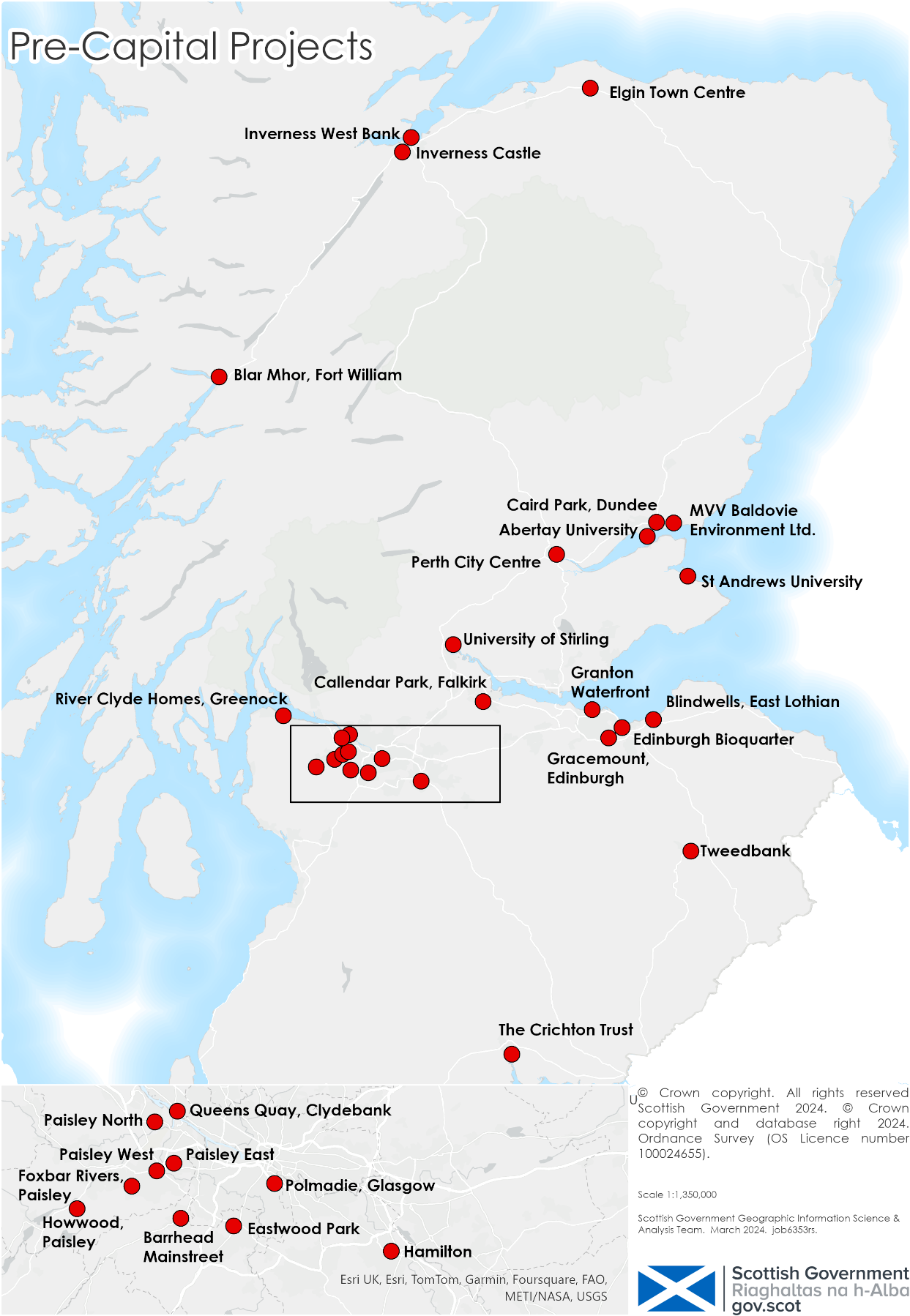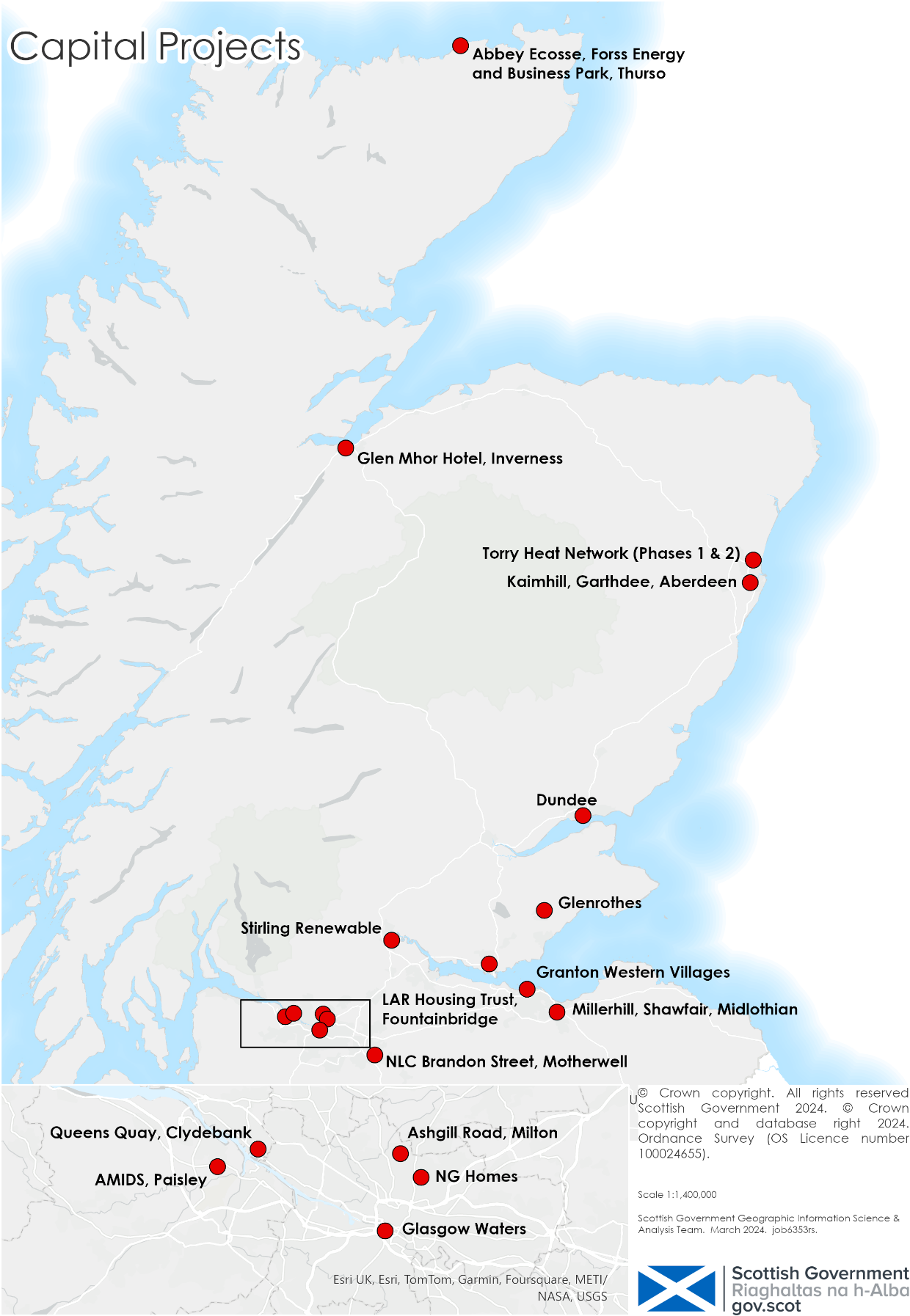Heat Networks Delivery Plan: review report 2024
The Heat Networks (Scotland) Act 2021 requires that the Heat Networks Delivery Plan (HNDP) is reviewed every two years, and that Scottish Ministers prepare a report of our progress towards meeting the provisions of the Act and other supporting policies. This report fulfils the requirement to review and report on the HNDP.
5 Our delivery programmes support for heat networks
5.1 Developing the district heating project pipeline in Scotland
5.1.1 In order to accelerate the growth of heat networks in Scotland, investing in the development of a project pipeline is essential. Having a stronger pipeline and better understanding of that pipeline will provide the market and wider stakeholders greater confidence in its delivery and, along with regulatory and policy development, will encourage the industry to invest in further skills and supply chain development.
Pre-capital support
5.1.2 The Heat Network Support Unit (HNSU)[22] was established in Autumn 2022 to address key challenges in the pre-capital stages of heat network development and to build capacity across the public sector to deliver successful projects. It is sponsored and managed by the Scottish Government, with partners Scottish Futures Trust and Zero Waste Scotland providing a range of support services.
Case Study: Granton Waterfront receives development support
The Granton Waterfront development, in the north of Edinburgh, will be served by a cost competitive, low carbon heat network. The proposed project will capture waste heat from the local sewer system and could serve up to 3000 homes, non-domestic space and local facilities that include a primary school and medical centre. The network will adopt a future proofed design, allowing for potential expansion to the North West of Edinburgh.
The Heat Network Support Unit has been providing detailed project development and commercialisation support to this project since 2022. Expert advice has also been provided by the Scottish Futures Trust, who are the financial, legal and commercial experts within the HNSU.
In 2023, the project progressed to the commercialisation stage. Utilising continuous project support, the City of Edinburgh Council commenced a two-stage procurement exercise to appoint a concessionaire to deliver and operate the heat network and subsequently conduct a package of pre-development activities. This exercise is the first of its kind on two fronts, being the first local authority led concession contract for a heat network and the first two-stage procurement process in Scotland.
The first of this two-stage procurement process is now complete, with Vattenfall Heat UK being proposed as the preferred bidder for pre-development work to refine and finalise the design of the heat network solution. The HNSU will continue to provide support throughout the pre-development period to financial close, when the concession agreement will be signed.
5.1.3 The HNSU support includes expert advice, project steering and funding for the pre-capital stages of heat network development, such as detailed feasibility studies, business case building and commercialisation. Support is available for new district heating schemes or extensions to existing district heating schemes.

Case Study: Perth City centre receives feasibility support
Perth & Kinross Council has received £36,000 of funding from the HNSU to conduct a feasibility study with the purpose of informing the council of the opportunity for a low carbon heat network in the Perth City centre area. The proposed heat network could supply heat to various buildings within the city centre, which include council offices, a theatre, hotel and various residential areas.
Commencing in November 2022, this project has been supported by Zero Waste Scotland, who are the technical experts within the HNSU. Working with appointed consultants and the HNSU, the project developed a robust feasibility study through activities such as stakeholder engagement, assessing heat loads and potential heat sources, considering energy infrastructure and undertaking technical and financial assessments.
The feasibility study was completed in March 2023 and identified a range of viable low carbon heat sources, which include river and ground source heat pumps. Following publication of their LHEES in late 2023, Perth City Council are actively engaging with the HNSU to develop next steps.
5.1.4 Since 2022, the HNSU has formally supported 28 pre-capital projects in 17 local authority areas through advice, guidance and funding, with the Scottish Government providing over £730,000 of financial support (see Map 1). Our quarterly Heat Network Projects report lists all supported projects, and the case studies in this section show some of the variety of the support given.
5.2 Supporting local authorities towards a stronger strategic approach for district heating
5.2.1 The projects that to date have received pre-capital support vary in size. To build on LHEES (see Section 6) and to support local authorities in developing a strategic approach to deploying large-scale heat networks at scale and pace in their areas, the Scottish Government enhanced its offering to local authorities through the HNSU by launching the Strategic Heat Network Support[23] in November 2023.
5.2.2 This support of up to 90% of the costs (capped at £150,000) can be utilised by local authorities only to fund the delivery of strategic heat network activities, for example those identified within their LHEES delivery plans. This may include:
- Additional technical work, such as characterisation and sequencing heat network zones, heat source evaluation etc.
- Commercial and financial analysis of heat network opportunities
- Assessment of overall district heating investment opportunity within a local authority area
- Exploration and identification of preferred delivery models
- Building the business case for long term district heating delivery.
5.3 Delivery models - potential to accelerate scale and pace of deployment
5.3.1 Delivery of large scale heat networks in Scotland has been led traditionally by the public sector, partially because they can bring demand assurance via their own estate, and have relationships with other public and private sector stakeholders within their areas. However, there are a number of existing and potential delivery models that a public sector organisation, in particular local authorities, may consider in trying to support the deployment of strategically important heat networks in their areas, for example by forming partnerships with other regional partners or the private sector.
5.3.2 To support central and local government in this process, the HNSU conducted a review of existing and new delivery models for heat networks in 2023. The report, published February 2024[24], details the characteristics of a range of delivery models - such as Regional ESCo, local authority joint venture, and concession models - and assesses their pros and cons against a number of key criteria. It makes recommendations for further activity regarding delivery models but also the wider heat network programme. We will continue to progress development of a number of the models highlighted.
5.3.3 From December 2023 to March 2024, the HNSU organised a series of in-person workshops for local authorities, the wider public sector and social housing providers to disseminate findings and stimulate thinking about ways to unlock the local potential in district heating.
5.4 Capital support
5.4.1 We continue to offer long-term support to enable the delivery of heat networks[25] with the £300 million Scotland’s Heat Network Fund (SHNF), launched in February 2022.
5.4.2 In order to drive value for money and financial sustainability and encourage private investment, SHNF offers a variety of financing mechanisms – including capital grants, repayable assistance and loans - to provide tailored support - to public and private sector organisations. Projects are required to demonstrate that their heat network can provide heat at an affordable cost to consumers and can support the eradication of fuel poverty.
5.4.3 SHNF remains open to applications throughout the year and over the course of this parliamentary session, with funding awarded on a competitive basis against the Funds’ mandatory criteria and until the total fund value has been reached. The SHNF website provides details including objectives, eligibility criteria, conditions of funding and the application process.

5.4.4 Since it was launched, SHNF has awarded £10.1 million of grant funding to four projects. This includes funding for the extension to Aberdeen City Council’s Torry Heat Network, which is decarbonising homes using recovered waste heat from a new Energy from Waste facility. The Torry Heat Network is demonstrating how waste heat can be used to retrofit the heating systems of hard-to-treat granite tenements and tackle high levels of fuel poverty.
5.4.5 SHNF has also provided support for low temperature – also known as fifth generation - heat networks, which can also be an efficient and cost effective way to install clean heating. Projects in Motherwell, Glasgow and Aberdeen have received support for the installation of ground source heat pumps in homes where the heat collecting pipework in the ground is shared between homes (also known as a shared ground array or networked heat pumps). Although ground source heat pumps have low running costs due to their high efficiency, the installation of ground loops or boreholes can make the upfront cost high. By spreading this cost across multiple homes and with support from SHNF, this enables the installation of highly efficient heat networks that align with net zero and deliver savings for residents.
5.4.6 SHNF continues the momentum created by its predecessor, the Low Carbon Infrastructure Transition Programme (LCITP). Although now closed to applications, the LCITP is supporting several projects currently under construction. The Social Housing Net Zero Fund (SHNZHF) has also funded district and communal heating projects. The total value of the current project pipeline across LCITP, SHNF and SHNZHF is over £69 million.
5.4.7 The projects receiving pre-capital and capital support via the HNSU and the Scotland’s Heat Network Fund are included in our quarterly reports to give potential investors, the supply chain and building owners considering connecting to a heat network a clear view on the pipeline of projects the Scottish Government is supporting.
5.5 Building Level Support
5.5.1 The offer of financial support from our schemes such as the Home Energy Scotland Grant and Loan Scheme, Energy Efficiency Business Support Service and Community, Renewable Energy Scheme and Social Housing Net Zero Heat Fund (SHNZHF) continues to include support for buildings to connect to nearby district heating networks. For example, Clydebank Housing Association is using funding from SHNZHF to contribute to the cost of the extension of the Queens’ Quay District Heat network, connect to the network, install heat interface units and carry out internal works. A small number of homes were also supported last year to connect to district heating networks through Area Based Schemes.
5.5.2 While take up of such support is currently very limited, as networks extend and new ones are developed, this support become more important.
5.5.3 We will also review our delivery programmes – starting with the Scottish Green Public Sector Estate Decarbonisation scheme - to ask whether a Building Assessment Report (see Section 4) has been carried out[26] before funding for energy efficiency and clean heating systems is provided (and request updated BAR is submitted after any works have been carried out with such funding). This is most important for non-domestic buildings, and any buildings with existing or planned communal heating systems.
Contact
Email: heatnetworks@gov.scot
There is a problem
Thanks for your feedback